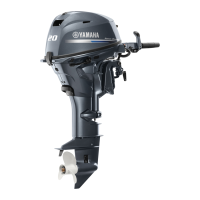Specifications and requirements
20
meets your engine’s requirements.
EMU41342
Gasoline Additives
Gasoline blends change to meet automobile
emission regulations and economic condi-
tions. Additives, added by gasoline distribu-
tors, necessary for proper automobile engine
operation and durability, may not be suffi-
cient for typical boat applications. Intake
valve and combustion chamber deposits
may accumulate in boat engines more rapid-
ly than encountered in automotive use. In ad-
dition, gasoline used for boating will typically
age longer between refills than gasoline
used in automobiles, resulting in stale and
unusable gasoline that may cause starting
and running problems, fuel system damage,
and internal engine damage.
Yamaha recommends the use of two Yama-
lube gasoline additives to reduce internal de-
posits and extend the storage life of
gasoline. Continuous use of Yamalube Ring
Free Fuel Additive Plus reduces harmful in-
ternal deposits. Yamalube Fuel Stabilizer &
Conditioner Plus added to fresh gasoline will
help protect the fuel system from varnishing
while helping to keep the gasoline’s octane
level from decreasing excessively during
storage. Other additives may also be avail-
able on the market that may have varying de-
grees of effectiveness. Consult your Yamaha
dealer concerning what may work best for
the locally available gasoline and environ-
mental conditions.
EMU36881
Muddy or acidic water
Yamaha strongly recommends that you have
your dealer install the optional chromium-
plated water pump kit if you use the outboard
motor in muddy or acidic water conditions.
However, depending on the model it might
not be required.
EMU41354
Anti-fouling paint
A clean hull is required to maintain your
boat’s performance. Boats moored in the wa-
ter should be protected from marine growth
(barnacles, mussels, and marine plants). If
approved by regulations for your area, the
bottom of the hull can be coated with an anti-
fouling paint to inhibit marine growth.
Anti-fouling paints specifically formulated for
use on aluminum may be applied to the out-
board motor. The original Yamaha paint sur-
face may be scuffed lightly before applying
anti-fouling paint, but do not remove the orig-
inal paint. Removal of the original paint will
increase the rate of corrosion.
ECM04821
Anti-fouling paint for fiberglass and
wood may contain materials, such as
copper, graphite, and tin, that can
cause corrosion if applied to aluminum
boats and outboard motor compo-
nents. Never apply these types of paint
to your outboard motor because rapid
corrosion damage could occur.
Anti-fouling paint can increase drag
(friction) between the boat and the wa-
ter, and possibly affect performance. If
the effects are too great, reducing pro-
peller pitch may be necessary.
6AG-9-3D-1E0.book 20 ページ 2015年11月5日 木曜日 午前11時7分

